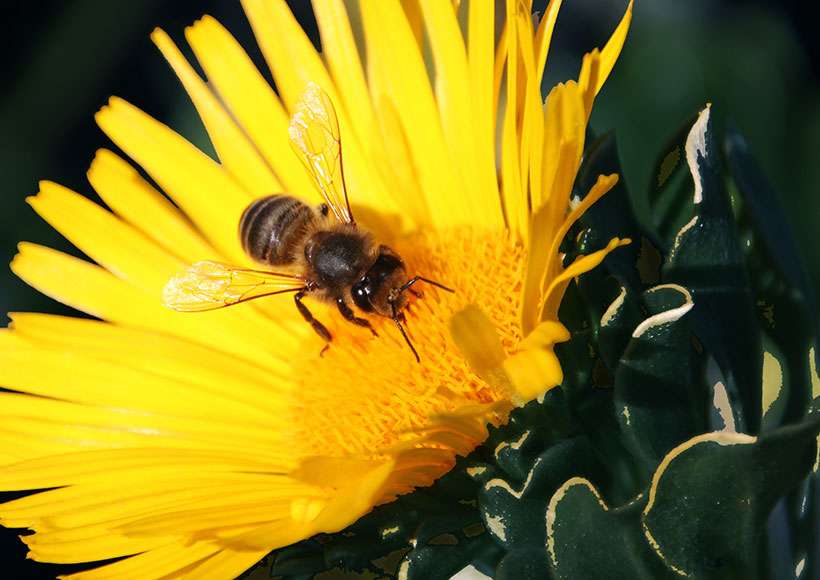Bees - a slow decline to extinction?
4.1 April 2017
I was sitting outside recently when my attention was caught by a lone bee manoeuvring in and out of the bushes searching for flowers. I was struck by the fact that her humble activity is vital to our survival. Most of us have forgotten that bees pollenate plants, which produce fruits, which we eat. Thus we sit-by without concern while the population of bees collapses.
Across the UK bees have been dying at an alarming rate. Managed Honey Bee colony populations fell by 53% between 1985 and 2005.1
Bees are recognized as a “keystone” of natural ecology. Pollination by insects is the main reproductive mechanism in 78% of temperate flowering plants and bees are the primary pollinators.
Such plants provide us with our food in the form of their seeds or fruit. Therefore pollination by bees is a critical aspect of agricultural production in the UK. Yet despite their essential role there has been little action to save the bee.
The dramatic decline in bee populations may be due to a combination of factor including disease, habitat loss, and chemical toxicity.
Various pests and diseases are thought to be the cause substantial losses in Honey Bee colonies. These include mites like Varroa destructor, fungi of the Nosema family, foulbrood bacteria, for example Melissococcusplutonius and several viruses.
Strict regulations on the importation of bees have been introduced to reduce the risks of introduction of diseases and pests.
Over the last fifty years agricultural production in the United Kingdom has shifted to an industrialised system characterised by large fields of monoculture crops. This has had a severe impact on the availability of suitable environments for foraging by bees and has been identified as one of the main reasons for their decline.
Industrial agriculture also depends on the use of increasing levels of herbicides and pesticides to control weeds and pests. These have several effects on bee populations.
Herbicides kill many flowering plants that previously would have provided food. The insecticides can have more direct effects including: reduced breeding success, lower disease resistance, disruption of homing senses, and death. In a report on “The decline of England’s bees” researches at Reading University state that:
“Insecticides have been demonstrated to have severe negative impacts upon bees.”1
The group of insecticides known as neonicotinoids are highly effective insect neurotoxins. The use of certain of these compounds, like Thiamethoxam and Clothiandin, has increased substantially over recent years.
They are absorbed by treated seeds and plants and can be found in both pollen and nectar. Research has found that this can have sub-lethal effects on foraging bees.
The UK Government’s own review of the science concluded that they “could not exclude the rare effects of neonicotinoids on bees in the field” but decided that the risk to bee populations, as they are currently used, is low.2
Others however, while recognizing that the control of pests is important to maintain farming yields, also see that production priorities should not outweigh the survival of the Honey Bee and the long term viability of food production.
Therefore regulations have been introduced to control the use of these toxins.
Additional research into the effects of certain neonicotinoids identified a high and acute risk for bees from exposure and consumption of residues in contaminated pollen and nectar. These potential chronic effects on colony survival were deemed to be unacceptable.
On the 24th May 2013 the European Union took action and enacted the Commission Implementing Regulation (EU) No. 485/2013 which introduced a complete ban on these substances for two years starting on 1st December 2013.3 This positive action is a rare and welcome step to save the bee
With the political will the UK Government could do more. For example bees would benefit from nationwide subsidies that promote the planting and maintenance of semi-natural areas like meadow, natural grasslands and the restoration of hedgerows.
What can we do? Gardens and allotments can provide useful foraging and nesting sites for bees. So, if you have one, plant diverse flowering plants and avoid the use herbicides or insecticides.
Pollination by bees is crucial to our natural environment and our food supplies. Prompt and strong action is required to halt the decline in population of both wild and managed bees.
We need to act, and quickly, to reverse their slow decline to extinction.

Bees - or not bees?
4.2 April 2017
That is the question we face as a society – a stark choice between two futures for the bee.
Firstly, we can maintain business as usual. We, or rather politicians, can decide to bow to the commercial interests of the pesticide manufacturers and the short term profits of agri-businesses. We can maintain industrialised agriculture across the USA and Europe and continue to drown its vast monoculture fields in chemical pesticides. The consequence will be the continued decline of wildlife across our once “green and pleasant land” and the inevitable decline to extinction of that most vital component of Nature’s ecosystem – the bee.
“Many wild bees…have been declining in abundance, occurrence and diversity at local and regional scales in Northern Europe and North America.”1
Bees are threatened by a range of factors including: intensive agriculture, pesticides, land-use changes, environmental pollution, invasive species, pathogens and climate change.1 Fundamentally bees are being exterminated by the activities of industrial civilization.
The US Department of Agriculture (USDA) reported that there were 2.59 million (8%) fewer commercial honey bee colonies in January 2016 than in the previous year.2 Other recent studies in USA have concluded that of some 1437 bee species evaluated 749 are declining.
More seriously 347 species, which play a vital role in plant pollination, are imperilled and at risk of extinction.3
“It’s a quiet, but staggering crisis… that illuminates the unacceptably high cost of our careless addiction to pesticides and monoculture farming”3
There is an alternative. A future where society decides to take action to halt the decline in bee populations and force politicians to take the bold step to ban the pesticides that have been shown to be detrimental to both wild bees and commercial colonies. In 2016 European Food Safety Authority (EFSA) published a risk assessment and concluded “high and acute risks for bees” from most pesticides particularly Imidacloprid and Clothianidin made by Bayer.5
“Pesticides, particularly insecticides, have been demonstrated to have a broad range of lethal and sub lethal effects on pollinators.”1
There is hope. In May 2013 the European Union demonstrated courage in the face of commercial pressure and imposed a temporary ban on the class of pesticides called neonicotinoids.
On 25th April 2017 the UK Minister of State for Agriculture, Fisheries and Food, George Eustice, announced a decision to reject applications by the National Farmers Union (NFU) for permission to use two banned neonicotinoids on oilseed rape crops in England.7 Thus, for one year at least, the UK Government has decided to keep bee-killing pesticides out of English fields.
The permanent removal of these toxic chemicals from the landscape, combined with wide-spread changes to agricultural practices to provide improved habitat and foraging, could witness the revival of natural and commercial pollinators.
Sorry did I forget to mention a third scenario
Where the widespread use of pesticides is allowed to continue unchecked. Bees become extinct and one of Nature’s key species in plant reproduction is lost forever. Of course scientists already have a solution – ”RoboBees!” Mankind can spend years in research and billions of dollars of investment to develop a range of robot pollinators:
“Swarms of autonomous robot bees could be enlisted to help fertilize crops and wild flowers.”8
“An insect sized drone that can pollinate flowers”8 is not science fiction – prototypes have already been developed by the National Institute of Advanced Industrial Science and Technology in Tokyo.8
What madness!
Bees are in real danger of extinction. Millions of colonies are being lost each year as chemical companies and agri-business spread toxic pesticides over our fields. Huge investments in hi-tech solutions like “RoboBees” are not the answer. The solution is quite simple – the European Union, the UK and US Governments should ban the use of insecticides, particularly neonicotinoids, permanently.


